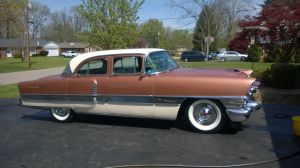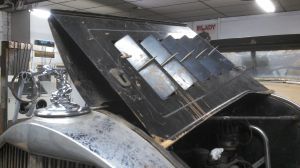- Home
- About Us
- Join/Renew
- Member Benefits
- Member Pages
- Log In
- Help
- Museum Store
Ed…I too bought a 1915 Ford T last year.
it is original and in the same family for 90 years. I intend to use it for running Pierce-Arrow parts. Before you buy the Packard, take it a few laps around Watkins Glen. It’s the least you can do before you defect. My Mother told me to never be swayed by a pretty face!
Re the mechanical complexity of Packard valve train vs Pierce. The question was asked above!
When I first started looking for a car to restore in 1980 I was interested in either Packard or Pierce, love them both. I have unjustifiable prejudices against Cadillac but not 2 of the 3 “P’s’. I found the Pierce I am currently working on before the ’36 Packard but the owner decided not to sell so I waited ten years and after my Packard restoration before getting it. It will be a few years before the Pierce is done so I can do a driving comparison. First I will say that my Packard has never failed to start in 30 years using 6V and original points and coil (except when I let the non-optima battery go dead from sitting too long – knock on wood). In the Packard Club of course I hear lots of snide comments about so and so’s Pierce that never starts. Probably has nothing to do with it being a Pierce.
The reason for the more complicated roller valve followers on Packard is of course to reduce wear on the camshaft. A nice attribute now that ZDDP has been eliminated from common engine oils since flat tappet engines can have problems without ZDDP. Of course the newest post-modern cars (modern cars are 1960’s) have reverted to more complicated roller followers for this reason. Engines with high loading, high piston speeds, and long life requirements usually have roller followers including WWII aircraft and Diesel engines. A problem with the simplest form of roller follower attached directly to the valve tappet is the high side loading put on the tappet guide. The swinging roller arm of the Packard 8 eliminates that side load and uneven wear of the tappet guide that occurs with simple flat tappets. That design dated to 1923 and is very long lived and reliable. The 1933 hydraulic tappet design of Pierce was very innovative and of course won out over the more complicated valve silencer arrangement of the Packard V-12.
I am eager to get my Pierce with it’s hydraulic lifters and 3 stage exhaust system going to compare with my Packard 8. Those hydraulic lifters with flat tappets are of concern, however. My engine was partially rebuilt in the 1960’s and based on what I have seen so far I don’t have a lot of confidence that the lifters were kept in their original positions. Typically of course with used cams and lifters, one is supposed to keep lifters on the same cam position as they originally wore in with to keep from having additional wear, possibly through the case-hardening. The saving grace is that it seems unlikely it will be driven more than 10,000 miles before the end of time. At any rate, It would be a couple less issues if the Pierce had roller followers a la Packard.
So there you have it, a blatant unapologetic heretic! Sometimes feel like a Quaker in a Southern Baptist convention!
Jim
So Ed,
HAVE YOU GONE OVER to the dark side yet?
Photos, and an explanation are required if so.
Stu

Yes, I did cross over. I helped a close friend inspect and research the history on a rather important Packard. We ended up making the purchase. I must confess, the one that we landed would be most welcome in my garage. I’m going to be working on it next week to try and sort a few things out, and put some miles on it before we deal with some cosmetic issues. I took it for a spin last week, it’s a 1932 and when comparing it to my Pierce series 54 1932 coupe the steering felt stiff, but I think it just needs some TLC to steer better. Brakes are about equal to Pierce, ride is not quite as good. BUT I must admit the car is quite national treasure. It is a very wonderful thing. Before you ask……. it’s a 1932 Series 904 Individual Custom Sport Phaeton body by Dietrich. (Yes, the split windshield impossible to find model.) I wish it was going to keep my Pierce Arrow’s company in my garage……..but such is life. I will admit to wanting a Lincoln or Stutz to keep my cars company at sometime in the future. My bucket list may have a few other cars if funding in the future is available.
Ok…here is the teaser. The garage/barn find car from November. I’m going to save the details for an article in the Arrow. If you know the car or have inside information PLEASE do not post what the car is. For the rest of the members here is a shot that will wet your appetite. There’s enough information in the photo to properly identify the years and series. Body style guesses must be kept to yourself, no posting answers please!

To James Chase: Thank you for an engineering explanation for the Rube Goldberg lifter designs in the Packard engines. It kinda-sorta makes sense, but I’m still amazed at the extent and degree of ‘going overboard’ that Packard went with this design.
An example is in the V12 ‘silencers’ The V12 roller has TWO layers of roller bearings. The roller design from the middle out: the central shaft is first, a set of rollers ride on this shaft, then a thin roller, like a piece of precision steel tubing goes over the inner rollers. Then on the outside of this thin roller is a second layer of roller bearings. And finally the outer thicker roller that rides on the cam lobe.
So each roller assembly has two layers of roller bearings. Each layer of roller bearings must be ground to very precise tolerances, and the rollers, rings and shaft have to be a high quality hardened steel. This is an amazing degree of over-kill, that probably caused and created a lot of maintenance and repair, instead of creating longevity. I know that the silencer assemblies for the V12 are a big stumbling block for engine rebuilders.. Most make a single new brass bushing to replace the double layer of roller bearings. The rust, wear and excess tolerances in the worn out roller bearings are pretty much a given for a Packard engine rebuild.
The Packard 8 has ‘only’ a single roller bearing in each lifter roller.
NOW in contrast, the Pierce Series 80/81 does have a direct acting roller riding on the cam lobe, and there is some side thrust on the lifter and lifter guide assembly. But the lifter guide assemblies are simple cast iron items, that usually need replacement due to breakage rather than due to wear. The breakage is done by someone loosening or tightening the lock nuts on the lifter adjusting screws, which will break the roller slot guides off the assembly.
Breakage, not wear has prompted a PAS member to reproduce the lifter guide assemblies.
I’ve only seen a few lifter guide assemblies that are too worn to go back into service, but I’ve never seen a Packard that didn’t need a full replacement of the lifter rollers and bearings.
The Series 80/81 rollers are a hard steel roller riding on a hard steel pins. The pins are drilled for an oil passageway, and cross drilled at the roller to let the oil onto the roller/pin oil space. The only problem occurs with infrequent oil changes and the oil drilling gets clogged with sludge.
Our Pierce camshafts don’t seem to suffer any excess wear from the rollers. Only from rust broken lifter guide assemblies letting the roller turn sideways.
I definitely like the simplicity of the Pierce designs.
The 8 and V12 Pierce engines have such generous camshaft lobe width, that if the engine is not allowed to sit and rust, the cam and flat tappet lifters usually don’t have excess wear. And ZDDP was not needed then nor is is needed now, the valve spring pressures are quite low in our low rpm engines so the high pressure anti-wear characteristics of ZDDP are not needed.
Greg Long
Jim Chase: My 1904 Oldsmobile one lunger(147 cubes)has a roller tappet. It’s of interest, that when Mr. Olds built my car, he was
entering his 17th year of producing automobiles!
Ed, when I bought my ’15 T, I did so to make me appreciate the
finer points of a gentleman’s conveyance( my ’12 P-A). Of course, a
side benefit is acquiring leg muscles the size of Popeye’s, and an
increased vocabulary of swear words needed when the T does what it
feels like.
I’m still wondering why we haven’t seen pictures of the Packard?
Craig…….it’s not on topic for the PAS, but as per your request………

Ed, That looks like a ’37 Hudson Terraplane…does it have the electric hand?
Wow!, as Packards go, they don’t much better than that!
Great car, congratulations! Stu
Ed, thanks for the picture, the car is stunning.
Man, if that’s the dark side, save a seat over there for me…….
I really like my ’38 1604 Packard convertible coupe, but it’s not even in the same league as that car…outstanding….
Ed, you get to play with all the right toys!!
SWEEEEEEET RIDE!!!!
Did you get snow tires with that? How does the heater work? How about taking us for a drive on the Cape this weekend? The weather is perfect for a leisurely drive… NOT! Seriously, is that somewhat close to Ford’s Washington blue? It is a beautiful (and elegant) color, dark side or not.
It’s NOT my car, I just help a friend keep them running and looking good. I am going to put some miles on it next week to be sure it’s reliable. I’m sure I will have an opinion on it after I get 500 miles on it. I must confess I think I will have a BIG smile while driving it. Some time one must compromise one’s standards to help out our fellow man.
